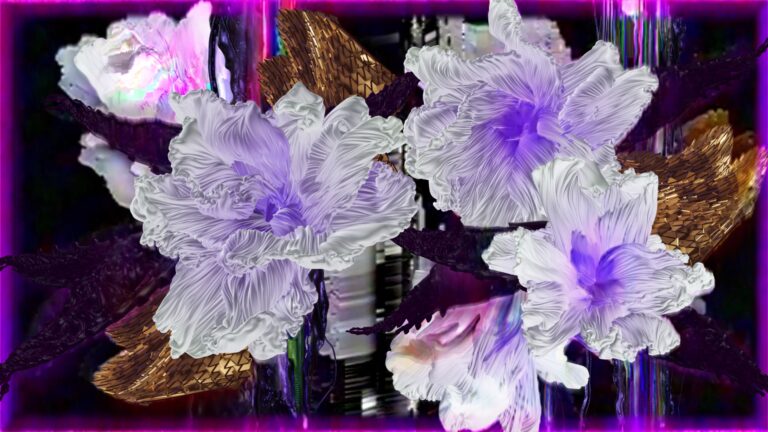
Artworks
Installations
Oh, my love, it’s you that I dream of
‘If you don’t immediately associate Belinda Carlisle to Harley Ives, have you even met Harley Ives?’ is a hypothesis worth testing. I knew of Harley’s fondness for the former-Go-Go’s-frontwoman-turned-successful-solo-artist before I knew of my fondness for Harley, and I was instantly fond of Harley.
Oh, my love, since that day
When I connected with Harley’s ‘Flower Still Life’ (2015), it transported me to a moment 25 years earlier.
I am 5. I walk around my first gem show, hand in hand with my mother. (Incidentally, Harley will later attend the high school whose hall plays host to this event). Beauty as I have never seen it before hits me between the eyes. I am face to face with new colour, new shape, new form. What is all of this?
My world expands. The objects morph in front of me. They wink as they refract light. I wink back in recognition. They are a bowl of yum cha jellies. I slurp them up. They are buried treasure, jewels of the earth, precious shimmering magical things. I protect them. The line between what is real in front of me and what is real in my mind blurs. Inner and outer blend. I swim in a pleasurable melt of imagination and perception. A template for transcendence is born. Wonder arrives.
I am 30. I walk around an art fair, hands clasped behind my back. I clock a still-life painting. It winks at me. Wait, what? It winks again. Harley’s moving still life glistens in front of me. Beauty as I have never seen it before. Once again. It hits me between the eyes. Before me, colours, shapes, and forms play in new and familiar ways. What is all of this?
My world expands as objects transform in front of me. I am looking at a floral arrangement, shimmering jewel box, a collection of quivering smudged objects, a floral arrangement. Visual trails. I rub my eyes. Tracers. They remain. They pulse in and out. A carefully orchestrated visual score. I am lost in a pleasurable dissolution of sensory boundaries. I swim in the melt. Wonder returns.
Somewhere in my heart
Transmutations pique my interest. They are at the centre of my experience of Harley’s work, animated as it is by the dynamic interweaving of alchemy, play, paradox, rebirth, kitsch, transcendence, and irony, with a nod to the transcendent everyday, aberration as beauty, and a gently wry, distinctly Australian brand of humour.
One of the things I love most about Harley’s work – and as a psychoanalytic psychotherapist this would be one of the things I love most about Harley’s work – is what emerges as his work loosens constrictive binaries into more expansive dialectics: a reckoning with our dynamic unconscious.
As humans, we get in our own way. Often unconsciously. We reduce complex situations to a suite of opposing pairs within which we then become stuck with the choice of siding with one or the other. Moving/static, old/new, masculine/feminine, high art/low art, trash/treasure, virtual/real, everyday/sublime, hard/soft, satirical/serious, deferential/derogatory, right/wrong . . . the list goes on.
The floral forms Harley constructs in Immaterial Ornament 4 contract and expand, over and over. Such billowing movement ripples through Harley’s work, as it collapses the either-or polarities we construct that ensnare us, and then opens them up and out into both-and dialectical tensions through which dialogue and reflection can flow. Immaterial Ornament 4 is video art, sculpture and painting, chaotic and contained, destructive and generative, contemporary and 17th century floral still life, frivolous and valuable, respectful and ironic, analogue and digital, kitsch and unassuming, calm and disruptive.
The process of transformation on offer in encountering Immaterial Ornament 4 is mirrored in its creation. Harley begins by searching online for 3D Models; “the shittier the better”, in Harley’s words. The day I visit Harley in his studio, the digital found object of choice is an especially soulless-looking koi. Harley brings it to life, colouring it in, and providing it with a skeleton. The backbone enables the object to be put through a movement simulation. Renewed with soul, the vivified koi is duplicated and arranged to make a flower. (Can you spot the petal slash fish tail?).
Once Harley has assembled a bouquet, he exports this initial digital composition onto a VHS tape, records the work from this tape to another, then to another, and then to another, before converting it back into digital form. This allows him to digitally manipulate the smears, distortions, streaks, glitches and other signs of degeneration in the video image, all of which he views as analogous to painterly marks. A core component of Harley’s visual practice and idiom is drawing to our attention the indexical markers of video materiality, all the while transposing them from the register of the unremarkable to the realm of a refined visual aesthetic. Pleasure is distilled.
I’m always dancing with you in the summer rain
Harley’s work centres on the destruction of rigid binaries. From their ashes rises a freer movement within, between, and across subject positions. We become aware of that which has ossified outside of our awareness, that which we have unconsciously disowned, pushed away, and labelled as not-me. We are taken outside of ourselves. We are woken from a state we slipped into unnoticed. The banal blends into the divine and we forget how we ever tried to distinguish between the two. At the risk of sounding kitsch while eagerly leaning into it, in Harley’s hands, perhaps Heaven truly is a Place on Earth.
Dr Andrew Geeves
Psychoanalytic Psychotherapist/Clinical Psychologist













